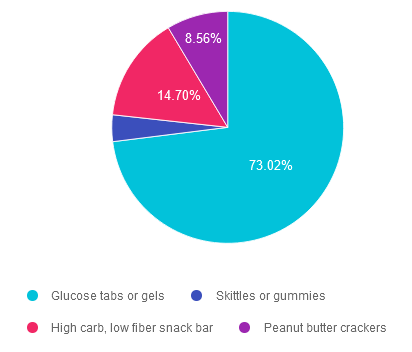For last week’s practice question, we quizzed participants on how to treat hypoglycemia while dealing with gastroparesis. 73% of respondents chose the best answer. We want to clarify and share this important information, so you can pass it on to people living with diabetes and your colleagues, plus prepare for exam success!
Before we start though, if you don’t want any spoilers and haven’t tried the question yet, you can answer it below: Answer Question

Question: JR has type 1 diabetes and was recently diagnosed with gastroparesis. JR is a runner and has not been able to exercise recently due to nausea, vomiting, bloating, and intestinal pain. They experience hypoglycemia about 3 times a week.
Based on this information, what is the best treatment for hypoglycemia?
Answer Choices:
- Glucose tabs or gels.
- Skittles or gummies.
- High carb, low fiber snack bar.
- Peanut butter crackers.

Getting to the Best Answer
Answer 1 is correct. 73.02% chose this answer. “Glucose tabs or gels.” Great job! Since JR has gastroparesis with slowed gastric emptying and delayed absorption of nutrients, we need to provide a fast acting carb that can instantly raise blood sugar. Fast absorption of sugar from glucose tabs and gels begins in the mouth, to quickly raise blood sugar levels.
Answer 2 is incorrect. 3.72% of you chose this answer. “Skittles or gummies.” Since JR has gastroparesis with slowed gastric emptying and delayed absorption of nutrients, we need to provide a fast acting carb that can instantly raise blood sugar. Gummies and skittles are more challenging to chew and need to be broken down in the stomach, which would delay the blood sugar from increasing to a safe level. Another consideration is that the ability to chew can be impaired when someone is experiencing significant hypoglycemia. Glucose tabs and gel, are quickly absorbed and require minimal chewing and are the best choice.
Answer 3 is incorrect. About 14.70% of respondents chose this. “High carb, low fiber snack bar.” Since JR has gastroparesis with slowed gastric emptying and delayed absorption of nutrients, we need to provide a fast acting carb that can instantly raise blood sugar. A snack bar, even though it is low fiber, is more challenging to chew and needs to be broken down in the stomach, which would delay the blood sugar from increasing to a safe level. Another consideration is that the ability to chew can be impaired when someone is experiencing significant hypoglycemia. Glucose tabs and gel, are quickly absorbed and require minimal chewing and are the best choice.
Finally, Answer 4 is incorrect. 8.56% chose this answer. “Peanut butter crackers.” Since JR has gastroparesis with slowed gastric emptying and delayed absorption of nutrients, we need to provide a fast acting carb that can instantly raise blood sugar. Peanut butter crackers are more challenging to chew and need to be broken down in the stomach, which would delay the blood sugar from increasing to a safe level. Another consideration is that peanut butter is a protein and fat combination food that would delay the absorption of the carbs from the crackers. Glucose tabs and gel, are quickly absorbed and would be the best choice!
We hope you appreciate this week’s rationale! Thank you so much for taking the time to answer our Question of the Week and participate in this fun learning activity
Unlock insights for managing diabetes distress with the experts!
Join us live on June 17th & 24th, 2024 for our
ReVive 5 Diabetes Training Program:

The 2024 ADA Standards of Care now recommends annual screening for diabetes distress. If you are wondering how to screen for distress and tailor education based on the results, we encourage you to join this unique training program.
This two-session training provides the essential steps to address diabetes distress combined with an innovative approach to helping people make sense of their glucose data.
The first session is team-taught by experts in the field of diabetes distress and effective communication approaches. Dr. Larry Fisher kicks off the program by describing the difference between depression and distress and interpreting Diabetes Distress screening results. Dr. Susan Guzman uses a case study approach and step-by-step communication strategies to address responses from the Diabetes Distress screening tool. This session includes an abundance of evidence-based approaches that you can apply in your clinical setting.
Coach Beverly leads the second session. During this three-hour program, Beverly describes insulin dosing strategies, meter and sensor data interpretation, and common issues encountered by people using diabetes technology. Case studies include tools to help individuals discover what changes are needed to get glucose to target, coupled with the communication skills discussed in the first session. In conclusion, the team of instructors review a case study that pulls together all the ReVive 5 elements.
“ReVive 5” breathes new life into our relationship with diabetes, bringing a fresh perspective to both the person with diabetes and the provider.
Can’t join live? That’s okay. Your registration guarantees you access to the recorded version of the series, along with podcasts and resources for one full year.
Accredited Training Program:
- 15+ CEs – Includes the 7-hour ReVive 5 Training Program, Certificate, and 5 FREE bonus courses to supplement content.
- A comprehensive set of assessment tools, educational materials, log sheets, and resources.
Team of Experts:
ReVive 5 is taught by a team of 3 Interdisciplinary Experts:
- Lawrence Fisher, Ph.D., ABPP, Professor Emeritus, UCSF
- Susan Guzman, PhD
- Beverly Thomassian, RN, MPH, CDCES, BC-ADM
Speakers Interviews – Learn more about the ReVive 5 Team
Sign up for Diabetes Blog Bytes – we post weekly Blog Bytes that are informative and FREE! Every week we post one exam practice Question of the Week and Rationale of the Week. Sign up below!
Accreditation: Diabetes Education Services is an approved provider by the California Board of Registered Nursing, Provider 12640, and our CPEU courses have received Prior Approval* from the Commission of Dietetic Registration (CDR), Provider DI002. Since our CPEU courses received Prior approval* from the CDR, these CPEU courses satisfy the CE requirements for the CDCES /BC-ADM regardless of your profession!
The use of DES products does not guarantee the successful passage of the certification exam. CBDCE and ADCES do not endorse any preparatory or review materials for the CDCES or BC-ADM exams, except for those published by CBDCE & ADCES.









